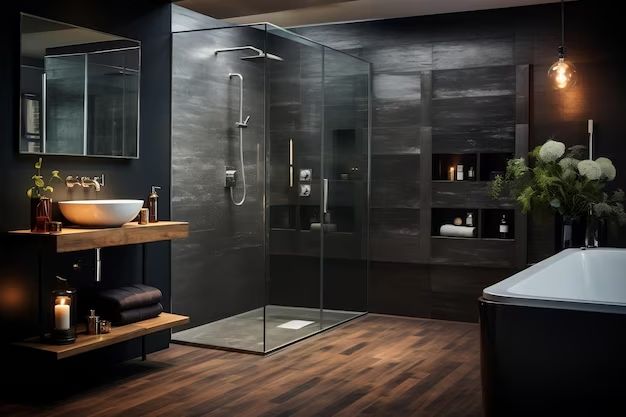When installing a bathroom in your basement, one of the most important considerations is what kind of pump you will need to remove wastewater. Unlike bathrooms located above ground, basement bathrooms require specialized pumps to push the wastewater up and out of the basement into the main sewer line.
Page Contents
What are the options for basement bathroom pumps?
There are two main types of pumps designed for basement bathrooms:
- Sewage ejector pump – This pump is installed below the basement floor and grinds the wastewater before pumping it upwards through a discharge pipe. It can handle solids and thick liquids.
- Effluent pump – Also called a sewage lift pump or grinder pump. It is designed to sit inside the holding tank and pump thinner liquids upward to the main sewer line. It cannot handle solids.
The type of pump you need depends on your specific basement bathroom setup. An ejector pump is a common choice because it can handle all waste, including solids from toilets. An effluent pump may work if you have a holding tank that separates and grinds solids first before pumping liquids upward.
Sewage ejector pump
A sewage ejector pump is the most versatile option for a basement bathroom. It sits in a sump pit below the basement floor and is able to pump all waste upwards. Key advantages include:
- Can pump both liquids and solids – Works with all standard basement bathroom fixtures including toilets
- Self-priming design – Can lift waste from below ground without pre-filling the pump
- Grinder impeller – Breaks up solids into slurry before pumping
Ejector pumps require a sump pit with roughly 24-30 inches diameter to install. The pump itself sits at the bottom of the pit while wastewater flows in from the bathroom fixtures. These pumps range from 1/3 to 1 horsepower for residential applications.
Effluent pump
An effluent pump is designed for graywater waste only. It cannot handle solids. Key features include:
- Sits inside a holding tank
- Pumps liquid waste only
- Requires gravity flow or grinding of solids first
Effluent pumps require the use of a holding tank, such as a septic tank, to collect and separate bathroom waste. Solids settle out in the tank while the effluent pump only needs to pump liquid upstairs. These pumps are not recommended for full basement bathrooms with toilets since solids would build up in the tank and clog the pump.
What size and capacity pump is needed?
Choosing the right pump size comes down to two key factors:
- Pumping capacity – Measured in gallons per hour (gph). Needs to exceed the peak flow rate from fixtures.
- Pumping height – Determines the power needed to push water vertically. Measure height from pump to sewer line.
For pumping capacity, add up the peak water flow in (gph) from all fixtures that will use the pump:
| Fixture | Typical Peak Flow (gph) |
|---|---|
| Toilet | 200 gph |
| Bathroom sink | 15 gph |
| Shower | 30 gph |
| Bathtub | 25 gph |
For a bathroom with a toilet, sink, and shower, the total peak flow would be around 245 gph. Size your pump to match or exceed this flow rate.
In terms of pumping height, measure vertically from where your pump will sit to the point where it connects to the sewer line. Typical pumping heights are 10-15 feet. Choose a pump rated for at least the height required in your basement.
Where and how should the pump be installed?
Proper installation of a basement sewage pump is critical for functionality and to avoid backups or flooding. Here are some key tips:
- Install a sump pit – Whether for an ejector or effluent pump, you need a sump pit dug below basement ground. This collects waste and houses the pump.
- Position pump below fixtures – Pump must sit at lowest point to remove all wastewater via gravity flow.
- Secure discharge plumbing – Rigid PVC pipe recommended for reliability. Slope pipe upwards at 1/4 inch per foot.
- Install check valve – Prevents backflow of sewage down into the pump pit.
- Vent system correctly – Helps pump prime and prevents airlocks. Tie vent line into main stack.
- Provide electrical hookup – Dedicated 15-20 amp GFCI circuit needed to power most pumps.
Be sure to size the sump pit large enough to hold pump, float switches, and some waste water. A 2 foot diameter pit is typical for a single bathroom. Hire a professional if you are unfamiliar with proper sewage pump installation.
How much does a basement bathroom pump system cost?
A grinder pump system for a basement bath can cost $2000 to $4000 installed. However, costs vary based on:
- Pump type – Ejector pump more expensive than effluent pump.
- Pit size – Larger capacity pits cost more to install.
- Piping – Long discharge runs require more piping material.
- Labor – Expect professional installation to add $1000 or more.
- Permits – Your local codes may require permitting fees.
Get estimates from multiple plumbers to find the best value. And remember to account for potential maintenance down the road – pumps have ~10 year lifespan before needing rebuild or replacement.
Key takeaways on basement bathroom pumps
- Choose a sewage ejector pump for best performance with toilets/solids.
- Calculate required pump capacity based on fixture flow rates.
- Install a proper sump pit and discharge plumbing.
- Hire a professional if you lack experience with pump systems.
- Budget $2000 to $4000+ for a typical basement bath setup.
Installing the right pump system allows you to add a bathroom virtually anywhere, even below ground. Careful planning and quality installation will lead to reliable performance for years of trouble-free service.

